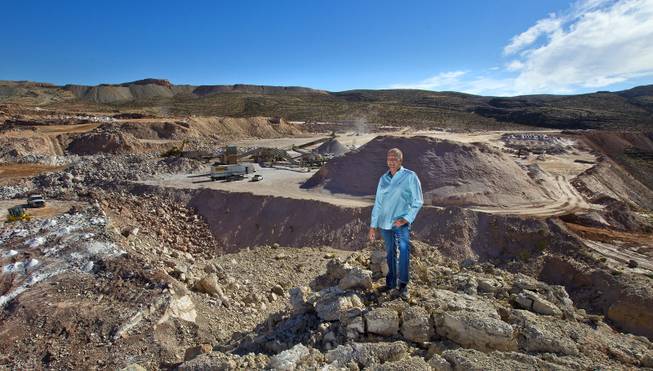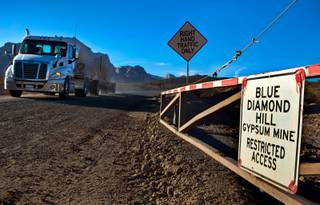
L.E. Baskow
Las Vegas developer Jim Rhodes looks on as gypsum is processed at the Blue Diamond Gypsum Mine out near the Red Rock Canyon National Conservation Area on Wednesday, April 16, 2014.
Monday, Oct. 17, 2016 | 2 a.m.
Compared with the classic battle between development groups and activists, the forces in this decade-long scuffle are friendly, or at least familiar with each other. When interests aligned, they even once collaborated. But that effort hit a regulatory snag. And as Las Vegas developer Jim Rhodes restarts an effort to put a master-planned community on a hill overlooking Red Rock Canyon, the groups are again in conflict.
“I love the development,” said Heather Fisher, who is leading opposition as the president of advocacy group Save Red Rock. “It’s just the wrong location. Red Rock shouldn’t have a big city in it.”
Although the development would be on private land outside the boundaries of the national conservation area, it would be big. Developers are planning 5,025 units over 2,010 acres, according to a concept presented in a recent Clark County planning meeting. The plans also could include parks, schools and cafés.
The proposed development, near the town of Blue Diamond on a hill where Rhodes’ Gypsum Mine unearths the mineral used in plaster and chalk, would extend east in the direction of the Red Rock Visitor Center. Rhodes’ goal is to reclaim the mine over the next decade in order to transform the land.
Opposition groups worry that a master-planned development is an encroachment on Red Rock. Others worry about the ecosystem and light pollution. And at a county meeting, an official from the Mountain’s Edge community raised the issue of more traffic in the area.
Ron Krater, a project consultant, said the developer has addressed many concerns. Clark County initially signed off on the plan in 2011 — that approval has since expired — and placed conditions on the project. Krater said the new plan incorporates many of those requirements, including a reduction of about 2,000 dwelling units. It avoids sending traffic through the canyon and attempts to lessen the impact of light.
“The land can’t just sit out there forever,” he said. “Something’s got to happen with it.” But, he added, “(The plan) respects the context of the property.”
Underneath the tension between the two factions is a fundamental disagreement over how the land should be used. Fisher argues that the land can be developed but only under its existing zoning, which would allow for low-density residential homes, while Rhodes has long wanted something more ambitious.
“You are talking about a city the size of Boulder City up there, and that’s different than just a little rural neighborhood,” Fisher said. “There are 2 million people here. There is one Red Rock Canyon. There is one campground. They need a place to get away.”
The developer has been bullish about getting the land rezoned, at times pitting himself against state and local politicians. When Nevada and Clark County passed rules in 2003 that prohibited increased density near Red Rock’s outlying areas, Rhodes’ company successfully challenged the statutes in court. Now, after staying a vote in September, county planners will vote on a preliminary project plan Tuesday (Save Red Rock has been trumpeting the opportunity for the public to voice concerns). Then it will go to the commission, after which the county will begin requesting more specific plans.
There is a sense that neither side wanted it to come to this.
The county gave Rhodes’ company Gypsum Resources approval for the project in 2011, but Rhodes put the plans on hold amid public opposition.
With those vocal groups, the developer came up with a possible solution: Gypsum Resources would exchange its Blue Diamond parcels with the Bureau of Land Management and build the development elsewhere. After years of negotiations, though, the agency denied that request because it saw little resource value in the Gypsum land, largely because of years of mining activity that the BLM saw as a liability.
“It’s off the table now,” said John Asselin, a BLM spokesman.
The decision sent Gypsum Resources back to the county planning board, where it submitted a plan this year to start where it left off in 2011. Krater said the land is going to be developed regardless and argues the master-planned proposal is a balanced approach that tries to correct many of the past concerns.
“I know these folks on a first-name basis,” Krater said of his several decades working with local conservationists. “We really tried to do another option and it just didn’t work. But we’ve got to move forward. And I feel a responsibility to the land and them, to mitigate the impacts as best we can.”


Join the Discussion:
Check this out for a full explanation of our conversion to the LiveFyre commenting system and instructions on how to sign up for an account.
Full comments policy